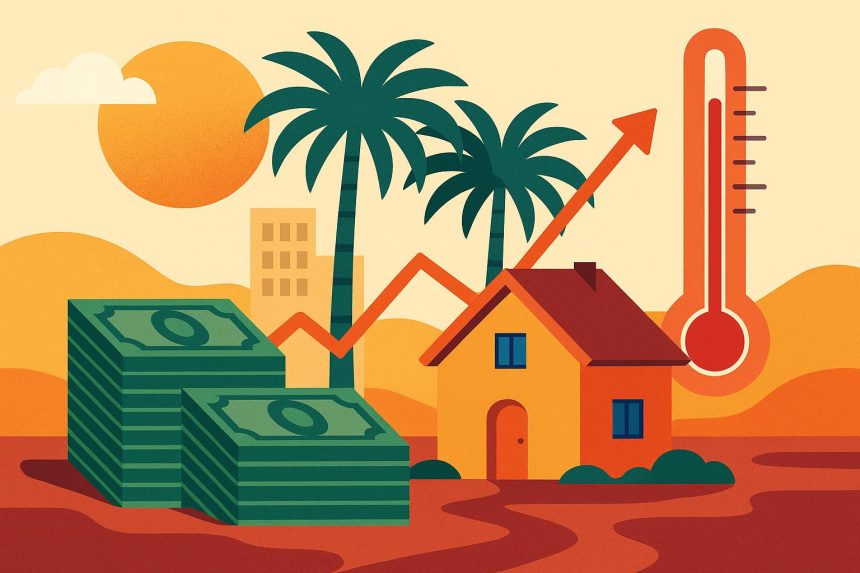The Sunshine Isn’t Always a Bargain
The Sunbelt has long attracted families and retirees with its promise of warm weather, lower taxes, and affordable housing—at least compared to coastal metros. States like Florida, Texas, and Arizona continue to see waves of new residents chasing a simpler lifestyle and more room for their money. Yet as many recent movers have discovered, the true cost of living involves more than home prices and sunshine. Rising insurance premiums, higher storm preparation costs, and sprawling transportation needs all play a role in how far a paycheck really goes. For families feeling stretched by these unexpected expenses, exploring tools such as Florida debt relief can be one way to regain balance and build financial breathing room.
Housing: A Promise That’s Getting Harder to Keep
Housing affordability was once the hallmark of the Sunbelt, but that advantage has narrowed. Cities like Tampa, Austin, and Phoenix have seen double-digit rent and home price increases in recent years, driven by population growth and limited supply. Even smaller towns within commuting distance of major metro areas are feeling the ripple effects.
While homes may still be cheaper than in New York or Los Angeles, property taxes and homeowner association fees often surprise newcomers. Maintenance costs can also climb quickly, especially in regions with extreme heat or humidity that wear down roofs, air conditioners, and plumbing systems.
Renters aren’t immune either. Demand for apartments near job centers has pushed rental rates higher, forcing many households to spend more than the recommended 30 percent of income on housing. Understanding local zoning trends and development plans can help residents anticipate whether prices are likely to rise further or stabilize.
Insurance Costs: The Hidden Expense of Sunshine
Home insurance in many Sunbelt states has become a significant—and sometimes volatile—expense. Florida and Texas, for instance, have seen homeowners’ insurance premiums spike due to severe weather claims, rising construction costs, and insurer withdrawals from high-risk regions. Some families find themselves paying several thousand dollars annually just to maintain adequate coverage.
Even renters face higher costs, as landlords pass along the price of insurance increases through rent hikes. Vehicle insurance rates are climbing too, thanks to higher accident rates and expensive repairs caused by flooding or hail.
To manage these costs, it pays to shop around annually, bundle home and auto coverage, and explore state-backed insurance options where available. The National Association of Insurance Commissioners provides tools to compare average premiums and check insurer reliability before signing a policy.
Storm Preparation and the Price of Security
Living in hurricane, flood, or wildfire zones adds another line to the budget that many newcomers underestimate: preparation. Whether it’s hurricane shutters, backup generators, or emergency supplies, these essentials can easily total thousands of dollars. And since severe weather is becoming more frequent, preparation isn’t just a one-time investment—it’s an ongoing one.
Some households offset these costs through community resilience programs or local government grants. Many counties now offer rebates for installing impact-resistant windows or strengthening roofing systems. Taking advantage of these programs can help minimize both risk and recurring repair expenses.
Still, storm-related costs extend beyond the tangible. When power outages or evacuations disrupt work, lost income can compound financial stress. Having a financial cushion or emergency fund is vital, particularly in areas where recovery periods can stretch for weeks.
Transportation: The Suburban Cost of Mobility
Unlike dense urban centers, most Sunbelt cities are built for driving. Public transit options tend to be limited, making vehicles a necessity rather than a choice. While gas prices may be lower than in northern states, long commutes, rising insurance rates, and the need for frequent maintenance can make transportation one of the largest ongoing expenses.
For families with multiple earners, owning two or three cars may feel unavoidable. Yet there are ways to trim costs without giving up mobility. Carpooling networks, employer-sponsored transit benefits, and electric vehicle tax credits can all help reduce monthly expenses. Even simple habits—like grouping errands or maintaining tire pressure—add up to meaningful savings over time.
Transportation infrastructure also shapes how future costs evolve. As cities expand outward, commute times often lengthen, and wear and tear on vehicles increases. Keeping these trends in mind when choosing where to live can prevent transportation expenses from overtaking the budget.
Balancing Sunshine With Smart Planning
The appeal of the Sunbelt remains undeniable: mild winters, thriving job markets, and lower overall tax burdens. But those benefits come with tradeoffs that can erode financial comfort if not managed proactively. Creating a realistic budget that includes home maintenance, insurance fluctuations, and emergency preparedness helps families stay ahead of the curve.
For those already struggling to keep pace with growing expenses, financial counseling and structured programs such as Florida debt relief can offer a path toward stability. Reducing debt frees up income for essentials and long-term goals, making it easier to enjoy the lifestyle that drew so many to the region in the first place.
By approaching Sunbelt living with both optimism and awareness, residents can build a lifestyle that balances comfort with sustainability—proving that financial peace of mind can shine just as bright as the southern sun.
Lynn Martelli is an editor at Readability. She received her MFA in Creative Writing from Antioch University and has worked as an editor for over 10 years. Lynn has edited a wide variety of books, including fiction, non-fiction, memoirs, and more. In her free time, Lynn enjoys reading, writing, and spending time with her family and friends.















